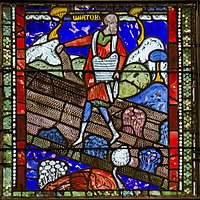
Photo from wikipedia
PurposeSide-to-side asymmetry in side-cutting manoeuvres is a known risk factor for severe knee injury. Potential leg asymmetry during ground contact times of different change-of-direction manoeuvres was evaluated in athletes by… Click to show full abstract
PurposeSide-to-side asymmetry in side-cutting manoeuvres is a known risk factor for severe knee injury. Potential leg asymmetry during ground contact times of different change-of-direction manoeuvres was evaluated in athletes by means of the recently developed SpeedCourt® system. The hypotheses were that ground contact times and the limb symmetry index are affected by age and the type of sports.MethodsOne-hundred and sixty-five athletes (149 men, 16 women, age 16.5 ± 5.1) of popular team sports such as football, team handball and baseball were assessed by means of three different tests [side-hop, lateral change-of-direction (COD) and diagonal COD] using the SpeedCourt® system. Analysis included the factors age, sex, type of sports, ground contact time, leg symmetry index and limb dominance.ResultsDuring lateral but not diagonal COD tests, football players had shorter contact times than players of team handball (p = 0.026) and baseball (p = 0.015) of the same age group. The side-hop tests yielded differences in the leg symmetry index between players < 16 years and players > 16 years (p < 0.01). Mean ground contact time differed in each of the side-hop, lateral COD and diagonal COD tests (143.5 ± 20.0 vs. 256.2 ± 66.1 vs. 320.4 ± 55.0). Contact times and test durations of side-hop, lateral COD and diagonal COD tests were shorter for older players (p < 0.01).ConclusionsGround contact times of side-hop and change-of-direction manoeuvres are influenced by age, the type of sports and limb dominance. Such information is fundamental for future sports medicine research and needs to be considered in pre-season screening or when used as a criterion for return-to-competition of players with previous severe knee injury. Assessment of change-of-direction manoeuvres should be included in future return-to-competition test batteries.Level of evidenceIII.
Journal Title: Knee Surgery, Sports Traumatology, Arthroscopy
Year Published: 2018
Link to full text (if available)
Share on Social Media: Sign Up to like & get
recommendations!